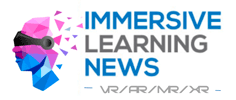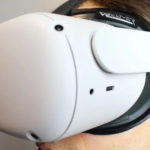Thanks to virtual reality, training is at the forefront of technological innovation. Discover all you need to know about immersive learning in the US.
What Is Immersive Learning?
When reality meets science fiction, training begins to explore new approaches, new tools with the potential to revolutionize the way we perceive pedagogy and memorization. Immersive training – or immersive learning in the US – provides a means to assimilate skills by interacting with a digital environment through a VR (virtual reality) headset or in a conference room using an avatar. You may have already encountered such devices as they are now very widespread in the gaming industry, though they constitute a rather unique training method. Let us get into the ins and outs of virtual reality training.
An Introduction to Immersive Learning in the US
Immersive Factory aims to transform “how industrial organizations train their teams on such strategic issues as health, safety and the environment”. Such a revolution could not have been initiated without a novel approach and a dash of fantasy. The result: impactful EHS immersive training, which provides workers with a highly effective solution to retain almost the entirety of the information they encountered. Our home page will allow you to see our offer and to learn how the VR training can be adapted to fit your own objectives.
Immersive learning in the US stems from the notion that experience aids in memorization. This innovative training method is based on a simulation, where the participant is immersed in a virtual environment. Every detail of this virtual reality training setting is designed with a purpose in mind. Thus, learners are confronted with situations that demand they put their theoretical skills into practice and “learn by doing” to help them remember the information. The virtual universe they evolve in is highly interactive and challenges both their mental and their physical alertness. As the relevance of the surroundings has a vast impact in the psyche, virtual scenarios capture the attention of the participant. The events that unfold encourage them to exert their mental faculties to react or reply within the allocated time. Finally, sensors round off the apparatus and translate the person’s movements into actions inside the simulation. Feedback is instantaneous and the experience is akin to a real-life challenge. It takes the shape of visual and auditory cues that the learner perceives thanks to the headset or speakers attached to the screen. A responsive platform can also be added to the set up to emulate walking and other types of movement.
Beyond the concrete sensations which greatly contribute to memorization, immersive training allows learners to make mistakes whose consequences remain entirely virtual and, as such, have no impact on the real world.
As digital devices are becoming more widespread (particularly thanks to the video game industry), immersive learning in the US is reaching businesses of all sizes. Hardware giants – such as HTC and Samsung – are now distributing high-quality VR equipment and making it available from a variety of outlets.
The Educational Benefits of Immersive Training
The principles of immersive learning in the US include several benefits, the main one probably being the active nature of the method. As the user is asked to perform a series of actions under real-life conditions, they focus all their attention on the tasks at hand. Instead of being placed among a group of learners who passively receive information, they need to personally involve themselves in their own training.
Active learning, when applied to immersive training, harnesses the benefits of virtual reality to make actions and sensations coexist. This translates into an educational approach which offers remarkable results. According to a study conducted by Capgemini, 82% of the companies where virtual reality has been used state that they have exceeded their objectives in terms of efficiency, productivity, and profitability. A PwC study from 2020 shows that learners who were trained through immersive learning were 4 times as focused as their e-learner counterparts and 1.5 times as much as with traditional training methods.
Optimal Engagement
One of the first characteristics at the heart of immersive learning in the US is all in the name: immersion. Gamification invites the participant to be constantly active and to engage personally in how the scenario unfolds. This presence translates into undivided attention and a strong identification with the situation. Learners feel directly implicated and the recreational aspect maintains that connection. This leads to the learner wanting to carry out their “mission” and, consequently, to them acquiring knowledge.
Better Memorization
This much personal commitment and motivation lead to a high level of memorization, which the experiential nature of virtual reality training strongly reinforces. Simulation creates a “place” where skills can be exercises and tested, which is particularly important in the case of EHS immersive training, for instance. The modules are made up of scenarios which branch out in various directions and allow learners to go through a whole array of experiences within the same program. Trainees can always interact with the module again some months later to anchor the notions they have learned perfectly and keep on practicing safely. A few minutes of immersive training are then enough to “reactivate” skills effectively.
Training Workers to Face Delicate or Dangerous Situations
Immersive learning in the US is designed to offer the same sensations and efficiency as real-life training. It allows participants to take the scenario very seriously, all while knowing they are not in any danger and that a mistake on their part will not lead to putting property or people at risk either. Learning to use sensitive equipment or to master complex tasks can then be done in a context where trainees feel perfectly confident, and without the fear of doing wrong creating any inhibition. Failure does not result in possible judgment on the part of co-workers, and risk-taking can even be encouraged. More action also means more practice, which contributes to the development of immersive skills and translates into concrete abilities.
A Different Approach to Training
Immersion learning in the US provides a different outlook on professional training, particularly in a context where typical interactions are being challenged for several industries. Without any geographical constraints, immersive training only requires minimal equipment to be implemented, regardless of the scale. Those wishing to work remotely can be given the possibility to evolve in the same “facility” as their colleagues, for instance. As for on-site teams, they no longer need to travel for training purposes, and a few minutes are all it takes to reactivate previously learned notions. This considerable time advantage contributes to short-term return on investment.
Beyond virtual reality training, this type of simulation may be used to test a variety of skills simply and effectively. Regardless of geographical location or schedule, having access to a VR headset is all that is necessary to submit to the exercise.
Immersive Learning in the US: Future-Focused Training
In a context where dematerialized training (e-learning) is becoming increasingly relevant, immersive training appears as the perfect solution to combine theoretical teachings with a practical approach. Exceptionally scalable, every detail of these tools can be adjusted thanks to some updates so that the content integrates new elements. Employees can then go through a VR session to learn all they need to know about how their own actions must reflect the changes implemented by the company as a whole.
Immersive learning in the US is also an invitation to work on some important – though sometimes neglected – soft skills. It is inscribed in an approach where the very notion of training can be reshaped. Personal behaviors – including empathy and civility – can be put to the test thanks to any module, even those supposedly designed for practical skill learning. Sales techniques are a perfect example of multidisciplinary know-how. When immersed in a virtual reality scenario, participants not only learn how to present their company’s services, but also how to apply subtlety in how they address the clientele.
The promises of VR are as diverse as they are relevant. The concept of immersive learning in the US is ideally positioned to become an extraordinarily reliable recruitment tool which places the candidate in a lifelike situation to evaluate their skills and allow them to discover the company through onboarding. Job interviews could take on a completely different shape and applicants would be given the opportunity to truly prove their worth!
Now making its way towards very eclectic fields, such as real estate or medicine, virtual reality is no longer just for the benefit of the aeronautic industry or the gaming market. Endlessly customizable digital environments offer great potential for visualization that goes far beyond what typical video media (such as e-learning software) can support. Immersive training creates a multisensory experience which modifies our relationship to knowledge and how we acquire it intrinsically. Finally, this extremely novel medium almost promotes a return to the “roots” of learning by conveying information empirically thanks to the reintroduction of a subjective dimension. Human beings enjoy making discoveries through their own experiences and thrive in contexts where they can draw their own conclusions from trial and error. Virtual reality puts back into our hands a power that passive education had cast aside. While technological media are sometimes branded as indolent, VR and immersive learning in the US are overturning this notion once and for all!
Quelle:
https://immersivefactory.com/actualite/119-Immersive-learning-in-the-US-What-is-virtual-reality-training-en



